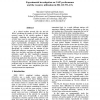Free Online Productivity Tools
i2Speak
i2Symbol
i2OCR
iTex2Img
iWeb2Print
iWeb2Shot
i2Type
iPdf2Split
iPdf2Merge
i2Bopomofo
i2Arabic
i2Style
i2Image
i2PDF
iLatex2Rtf
Sci2ools
LCN
2006
IEEE
2006
IEEE
Experimental investigation on VoIP performance and the resource utilization in 802.11b WLANs
In a shared medium network like the 802.11b WLAN, predicting the quality of VoIP calls from the resource usage of the wireless medium is highly desirable. Analyzing the bandwidth usage at the L2/MAC layer may be especially useful for potential QoS provisioning and call admission schemes. This paper experimentally investigates the relationship between resource utilization in WLANs and the quality of VoIP calls transmitted over wireless medium. Specifically we evaluate how the amount of free bandwidth influences transmission impairments (i.e. delay, loss, and jitter) and thus call quality. Resource utilization (under the MAC bandwidth components framework) is calculated by a WLAN resource monitoring application that passively “sniffs” packets at the L2/MAC layer and analyses their headers and temporal characteristics. The quality of VoIP calls is predicted using an extended version of the ITU-T Emodel, which estimates user satisfaction from time varying transmission impairments.
| Added | 12 Jun 2010 |
| Updated | 12 Jun 2010 |
| Type | Conference |
| Year | 2006 |
| Where | LCN |
| Authors | Miroslaw Narbutt, Mark Davis |
Comments (0)

